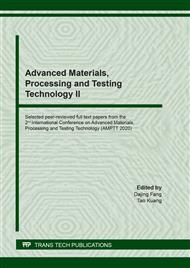p.3
p.9
p.14
p.20
p.27
p.32
p.40
p.46
High-Throughput Characterization of Composition and Performance of Titanium Alloys Based on Nanoindentation Technology and EPMA
Abstract:
Traditional high-throughput experiments increase the test efficiency by designing component gradient tests and other methods. This article intends to improve the traditional high-throughput experiments and proposes an experimental scheme combining nanoindentation technology and electron probe microanalysis (EPMA). Based on a new Ti-Mo-Al-Zr-Cr-Sn alloy, micro-region composition and corresponding performance at multiple indentations are directly characterized, including a series of different alloy compositions composed of 8 elements such as Mo, Al and the corresponding hardness (H) and elastic modulus (E). Then the principal analysis method in statistics, the theory of molybdenum equivalent and aluminum equivalent are used to process the obtained data, and a series of atlases such as "E-H-component characteristic parameters" and "E-H-alloy equivalents" are constructed, which has achieved high-throughput characterization of the relationship between composition and performance of titanium alloy. Related work can not only quickly determine the alloy composition range corresponding to high E and high H values, but also provide guidance for further optimization of titanium alloy composition design.
Info:
Periodical:
Pages:
20-26
Citation:
Online since:
January 2021
Authors:
Keywords:
Price:
Сopyright:
© 2021 Trans Tech Publications Ltd. All Rights Reserved
Share:
Citation:


